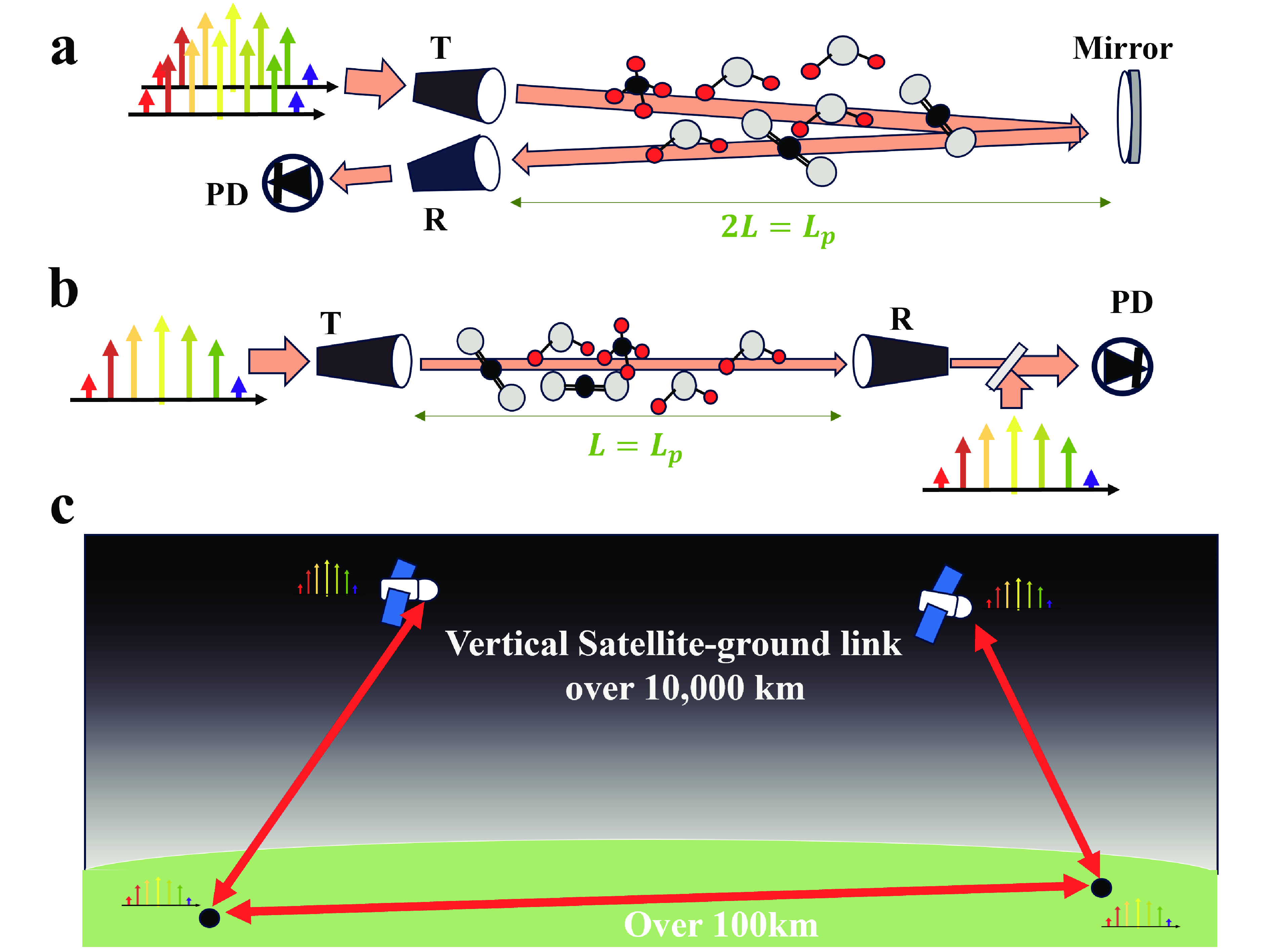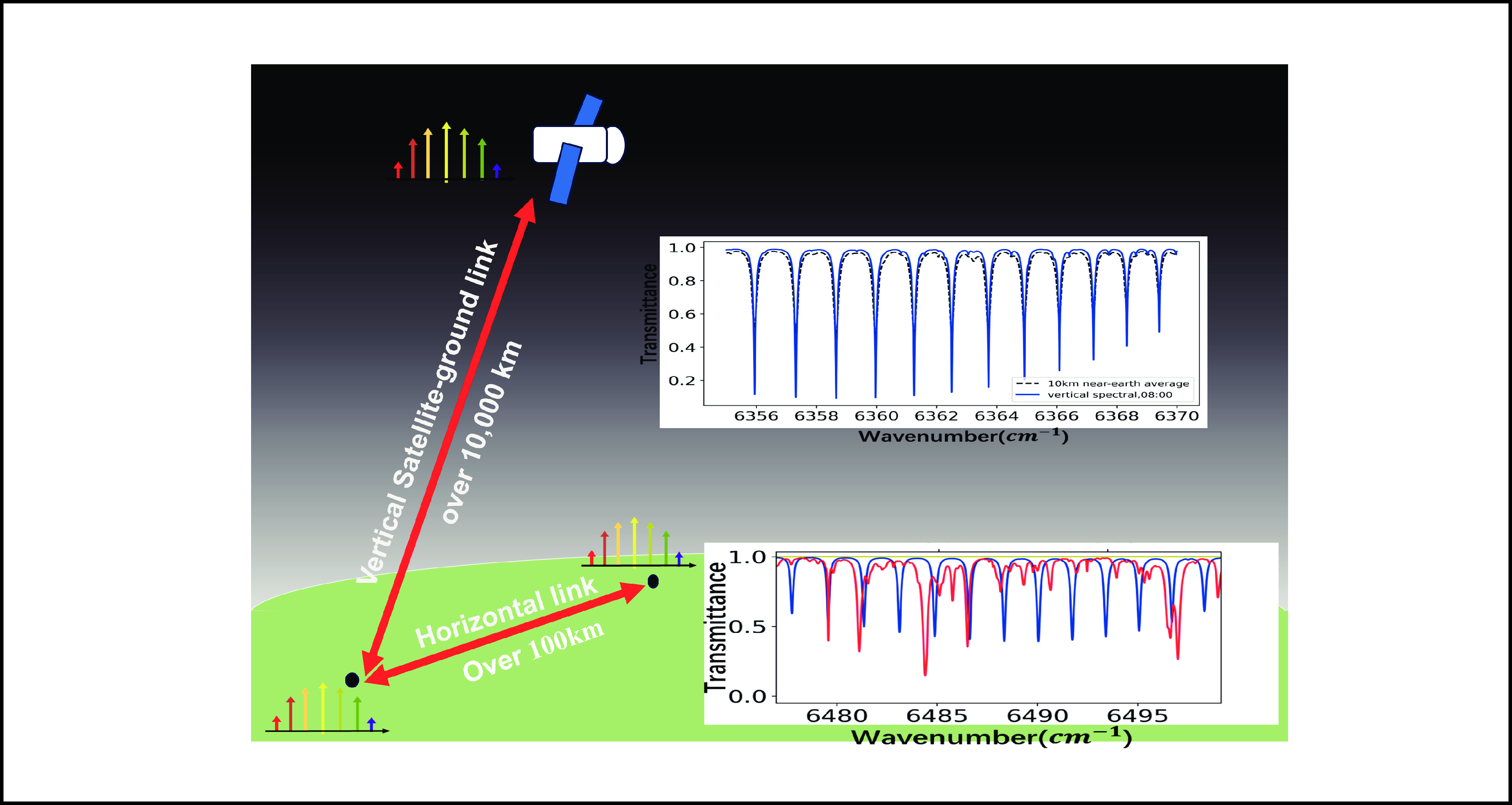
ISSN 0253-2778
CN 34-1054/N
Dual-comb spectroscopy (DCS) is one of the most promising technologies for ultra-long open-path multiple greenhouse gas detection. Ultra-long open-path DCS has the potential to realize detection configurations, such as horizontal open-path links over hundreds of kilometers and vertical open-path links between satellites and the ground base. Under these extreme detection conditions, identifying an appropriate wavelength band that ensures both technical feasibility and a reasonable absorbance for target components is critical but currently lacks studies. In this work, we simulate transmission spectra under different detection configurations to identify optimal wavelength bands for CO2 and CH4 measurement. The simulation results show that the

Selecting suitable wavelength bands for ultra-long open-path dual-comb spectroscopy, is necessary for building a future GHGs global monitoring network.
Figure 1. (a) Schematic of a typical open-path DCS setup for kilometer-scale detection. (b) Schematic of the configuration for achieving ultra-long open-path DCS. (c) Two main application scenarios for ultra-long path DCS: horizontal open-path links over 100 km and vertical open-path links from the satellite to the ground base, which exceeds 10000 km.
Figure
2.
Simulated normalized transmission spectra for horizontal open-path links. Simulations were performed using concentrations of 2 ppm methane, 500 ppm carbon dioxide, and 2000 ppm water vapor at 300 K and 1 standard atmospheric pressure. (a) Transmission spectrum for a 1 km path length, covering the wavelength range from
Figure 3. (a) Simulated normalized transmission spectrum for a 10 km horizontal open-path link. The simulation parameters are the same as those in Fig. 2. (b) Molecular number density profiles of three GHGs (methane, carbon dioxide, and water vapor). (c) The temperature profile over Hefei, China (117°E, 32°N), on January 5, 2015, derived from MERRA-2 specified dynamics (SD) assimilation data. See the text for further details.
Figure
4.
Simulated normalized transmission spectra for CO2 in the vertical open-path link (blue solid line). The black dashed line represents the transmission spectrum for a 10 km horizontal open path for comparison. (a) Transmission spectrum from
Figure
5.
Simulated normalized transmission spectra for CH4 in a vertical open-path link (dark yellow solid line). The black dashed line represents the transmission spectrum for a 10 km horizontal open path for comparison. (a). Transmission spectrum from
| [1] |
Sun Y, Yin H, Wang W, et al. Monitoring greenhouse gases (GHGs) in China: status and perspective. Atmos. Meas. Tech., 2022, 15 (16): 4819–4834. DOI: 10.5194/amt-15-4819-2022
|
| [2] |
Bellassen V, Stephan N, Afriat M, et al. Monitoring, reporting and verifying emissions in the climate economy. Nature Climate Change, 2015, 5: 319–328. DOI: 10.1038/nclimate2544
|
| [3] |
Cossel K C, Waxman E M, Finneran I A, et al. Gas-phase broadband spectroscopy using active sources: progress, status, and applications. J. Opt. Soc. Am. B, 2017, 34 (1): 104–129. DOI: 10.1364/JOSAB.34.000104
|
| [4] |
Schütze C, Lau S, Reiche N, et al. Ground-based remote sensing with open-path Fourier- transform infrared (OP-FTIR) spectroscopy for large-scale monitoring of greenhouse gases. Energy Procedia, 2013, 37: 4276–4282. DOI: 10.1016/j.egypro.2013.06.330
|
| [5] |
Sha M K, De Mazière M, Notholt J, et al. Intercomparison of low- and high-resolution infrared spectrometers for ground-based solar remote sensing measurements of total column concentrations of CO2, CH4, and CO. Atmos. Meas. Tech., 2020, 13 (9): 4791–4839. DOI: 10.5194/amt-13-4791-2020
|
| [6] |
Levin N, Kyba C C M, Zhang Q, et al. Remote sensing of night lights: A review and an outlook for the future. Remote Sensing of Environment, 2020, 237: 111443. DOI: 10.1016/j.rse.2019.111443
|
| [7] |
Schütze C, Sauer U. Challenges associated with the atmospheric monitoring of areal emission sources and the need for optical remote sensing techniques—An open-path Fourier transform infrared (OP-FTIR) spectroscopy experience report. Environ Earth Sci, 2016, 75: 919. DOI: 10.1007/s12665-016-5482-z
|
| [8] |
Fortier T, Baumann E. 20 years of developments in optical frequency comb technology and applications. Commun Phys, 2019, 2: 153. DOI: 10.1038/s42005-019-0249-y
|
| [9] |
Diddams S A, Vahala K, Udem T. Optical frequency combs: Coherently uniting the electromagnetic spectrum. Science, 2020, 369 (6501): eaay3676. DOI: 10.1126/science.aay3676
|
| [10] |
Schiller S. Spectrometry with frequency combs. Opt. Lett., 2002, 27 (9): 766–768. DOI: 10.1364/OL.27.000766
|
| [11] |
Lee S J, Widiyatmoko B, Kourogi M, et al. Ultrahigh scanning speed optical coherence tomography using optical frequency comb generators. Jpn. J. Appl. Phys., 2001, 40: L878–L880. DOI: 10.1143/JJAP.40.L878
|
| [12] |
Keilmann F, Gohle C, Holzwarth R. Time-domain mid-infrared frequency-comb spectrometer. Opt. Lett., 2004, 29 (13): 1542–1544. DOI: 10.1364/OL.29.001542
|
| [13] |
Yasui T, Saneyoshi E, Araki T. Asynchronous optical sampling terahertz time-domain spectroscopy for ultrahigh spectral resolution and rapid data acquisition. Appl. Phys. Lett., 2005, 87: 061101. DOI: 10.1063/1.2008379
|
| [14] |
Coddington I, Newbury N, Swann W. Dual-comb spectroscopy. Optica, 2016, 3 (4): 414–426. DOI: 10.1364/OPTICA.3.000414
|
| [15] |
Abbas M A, Pan Q, Mandon J, et al. Time-resolved mid-infrared dual-comb spectroscopy. Sci Rep, 2019, 9: 17247. DOI: 10.1038/s41598-019-53825-8
|
| [16] |
Coddington I, Swann W C, Newbury N R. Coherent dual-comb spectroscopy at high signal-to-noise ratio. Phys. Rev. An., 2010, 82: 043817. DOI: 10.1103/PhysRevA.82.043817
|
| [17] |
Newbury N R, Coddington I, Swann W. Sensitivity of coherent dual-comb spectroscopy. Optics Express, 2010, 18: 7929–7945. DOI: 10.1364/OE.18.007929
|
| [18] |
Chen Z, Yan M, Hänsch T W, et al. A phase-stable dual-comb interferometer. Nat Commun, 2018, 9: 3035. DOI: 10.1038/s41467-018-05509-6
|
| [19] |
Ideguchi T, Poisson A, Guelachvili G, et al. Adaptive real-time dual-comb spectroscopy. Nat Commun, 2014, 5: 3375. DOI: 10.1038/ncomms4375
|
| [20] |
Chen X, Huang C, Li J, et al. Phase-sensitive open-path dual-comb spectroscopy with free-running combs. Phys. Rev. Appl., 2023, 19: 044016. DOI: 10.1103/PhysRevApplied.19.044016
|
| [21] |
Khan S A, Khan S B, Khan L U, et al. Fourier transform infrared spectroscopy: Fundamentals and application in functional groups and nanomaterials characterization. In: Handbook of Materials Characterization. Cham, Switzerland: Springer, 2018 : 317–344.
|
| [22] |
Rieker G B, Giorgetta F R, Swann W C, et al. Frequency-comb-based remote sensing of greenhouse gases over kilometer air paths. Optica, 2014, 1 (5): 290–298. DOI: 10.1364/OPTICA.1.000290
|
| [23] |
Giorgetta F R, Rieker G B, Baumann E, et al. Broadband phase spectroscopy over turbulent air paths. Phys. Rev. Lett., 2015, 115: 103901. DOI: 10.1103/PhysRevLett.115.103901
|
| [24] |
Waxman E M, Cossel K C, Truong G-W, et al. Intercomparison of open-path trace gas measurements with two dual-frequency-comb spectrometers. Atmos. Meas. Tech., 2017, 10: 3295–3311. DOI: 10.5194/amt-10-3295-2017
|
| [25] |
Sinclair L C, Deschênes J-D, Sonderhouse L, et al. A compact optically coherent fiber frequency comb. Rev. Sci. Instrum., 2015, 86 (8): 081301. DOI: 10.1063/1.4928163
|
| [26] |
Truong G-W, Waxman E M, Cossel K C, et al. Accurate frequency referencing for fieldable dual-comb spectroscopy. Optics Express, 2016, 24 (26): 30495–30504. DOI: 10.1364/OE.24.030495
|
| [27] |
Coburn S, Alden C B, Wright R, et al. Regional trace-gas source attribution using a field-deployed dual frequency comb spectrometer. Optica, 2018, 5 (4): 320–327. DOI: 10.1364/OPTICA.5.000320
|
| [28] |
Waxman E M, Cossel K C, Giorgetta F, et al. Estimating vehicle carbon dioxide emissions from Boulder, Colorado, using horizontal path-integrated column measurements. Atmos. Chem. Phys., 2019, 19 (7): 4177–4192. DOI: 10.5194/acp-19-4177-2019
|
| [29] |
Shen Q, Guan J Y, Zeng T, et al. Experimental simulation of time and frequency transfer via an optical satellite–ground link at 10−18 instability. Optica, 2021, 8 (4): 471–476. DOI: 10.1364/OPTICA.413114
|
| [30] |
Han J J, Zhong W, Zhao R C, et al. Dual-comb spectroscopy over a 100 km open-air path. Nat. Photon., 2024, 18: 1195–1202. DOI: 10.1038/s41566-024-01525-9
|
| [31] |
Gordon I E, Rothman L S, Hargreaves R J, et al. The HITRAN2020 molecular spectroscopic database. Journal of Quantitative Spectroscopy and Radiative Transfer, 2022, 277: 107949. DOI: 10.1016/j.jqsrt.2021.107949
|
| [32] |
Yan D, Liu B, Song H, et al. Research status and development trend of high power femtosecond fiber laser amplifiers. Chinese Journal of Lasers, 2019, 46 (5): 0508012. DOI: 10.3788/CJL201946.0508012
|
| [33] |
Schlager H, Grewe V, Roiger A. Chemical composition of the atmosphere. In: Atmospheric Physics. Berlin, Heidelberg: Springer, 2012 : 17−35.
|
| [34] |
Gettelman A, Mills M J, Kinnison D E, et al. The Whole Atmosphere Community Climate Model version 6 (WACCM6). Journal of Geophysical Research: Atmospheres, 2019, 124 (23): 12380–12403. DOI: 10.1029/2019JD030943
|
| [35] |
Molod A, Takacs L, Suarez M, et al. Development of the GEOS-5 atmospheric general circulation model: Evolution from MERRA to MERRA2. Geoscientific Model Development, 2015, 8 (5): 1339–1356. DOI: 10.5194/gmd-8-1339-2015
|
| [36] |
Shakun A, Korablev O, Moshkin B, et al. Fourier transform spectrometers for remote sensing of planetary atmospheres and surfaces. CEAS Space J, 2017, 9: 399–409. DOI: 10.1007/s12567-017-0176-2
|
| [37] |
Weidmann D. 4 - Atmospheric trace gas measurements using laser heterodyne spectroscopy. In: Advances in Spectroscopic Monitoring of the Atmosphere. Amsterdam: Elsevier, 2021 : 159−223.
|